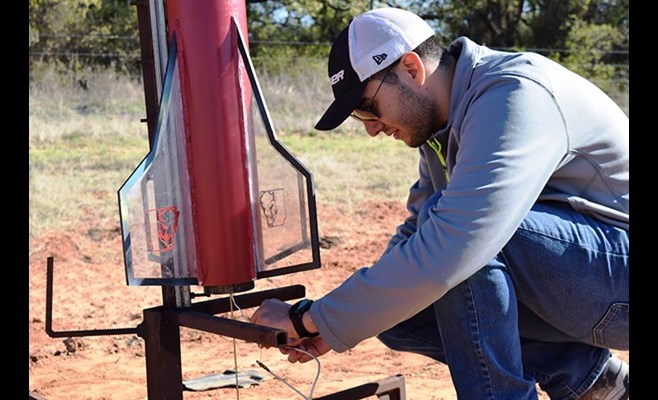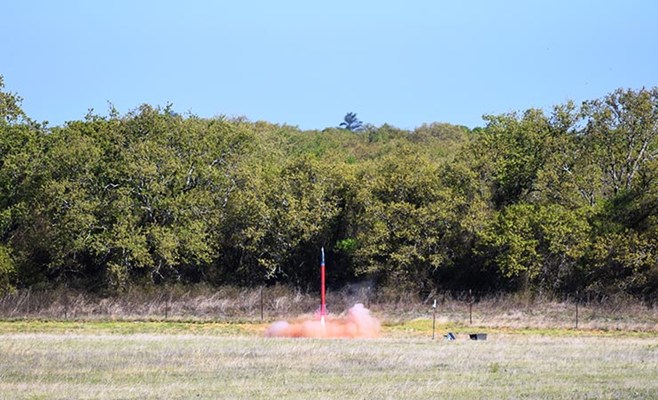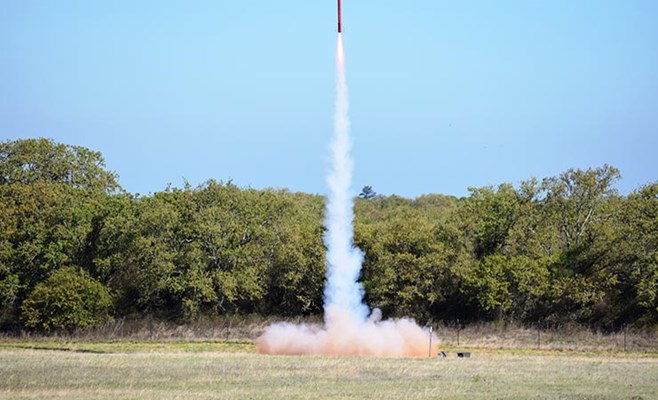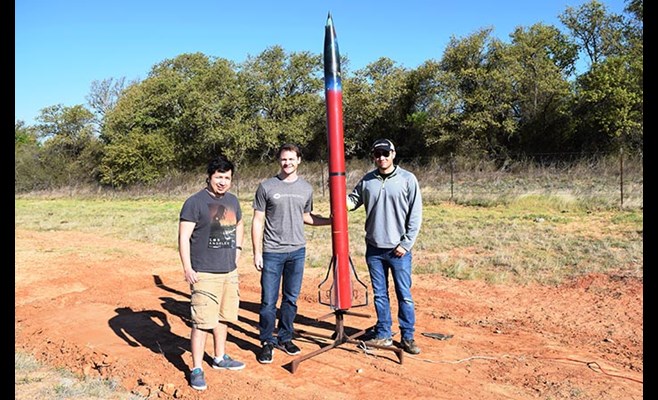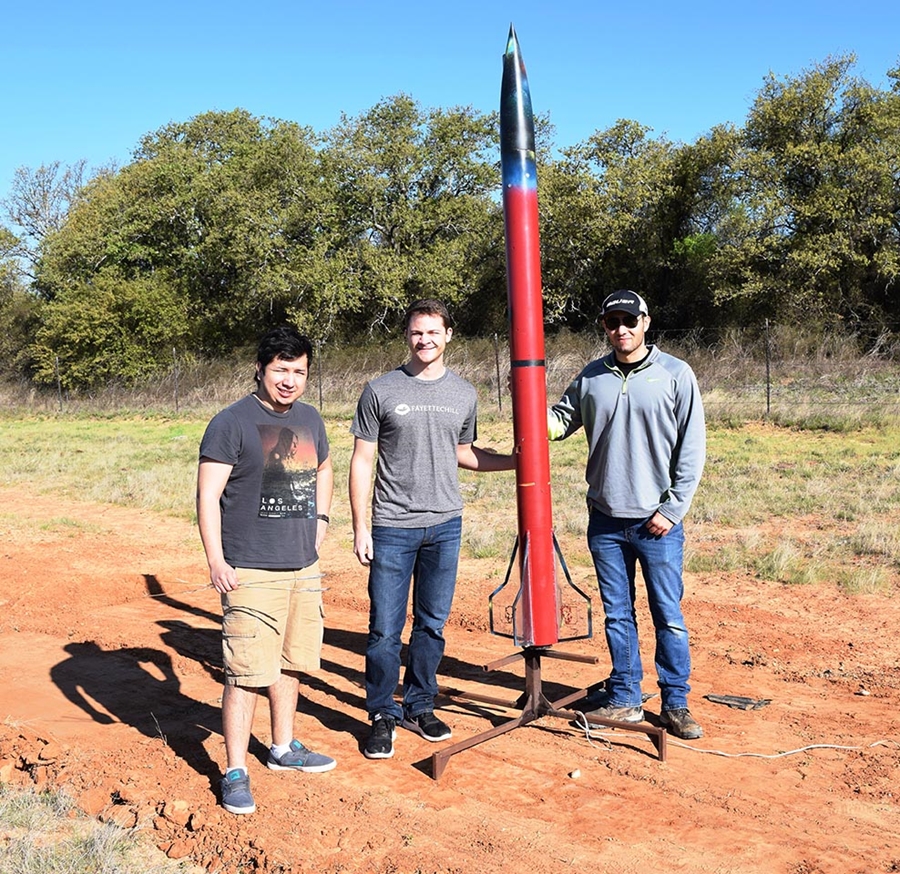Recent U of A Graduate Earns 2017 AFROTC Cadet Research Award
Jeffrey Overdorf, a class of 2017 cadet and mechanical engineering major, has earned the nationally competitive AFROTC Cadet Research Award, announced Chief Scientist Greg Zacharias of the U.S. Air Force. Overdorf has since become a 2nd lieutenant in the Air Force and will soon begin pilot training.
Representing the University of Arkansas, a team of four mechanical engineering seniors, led by Overdorf from AFROTC Detachment 030, competed in the NASA Student Launch Competition for rocket design and launch capabilities. The project had to produce a rocket that could achieve an exact altitude as well as to keep a sensitive payload protected from external forces.
The team included Overdorf, Grady Caton, Clay Hall, Tyler Kilambi, David Pacheco and Eric Torres.
For less than $1,200, the team created a rocket capable of achieving the altitude of 5,280 feet set by NASA. It was designed using only off-the-shelf materials with a few internal components created using a 3-D printer. This allowed the team to tailor the design to the specific needs of the competition while also keeping the overall cost considerably lower than most of their competitors.
The team's rocket utilized decelerator flaps to ensure the exact one mile altitude was achieved without being dependent on weather conditions. The sensitive payload design was completed by creating an outer and inner shell connected by a web of elastic shock cord with industrial springs on the top and bottom of the assembly, allowing the payload to be cushioned from both vertical and horizontal forces.
What was unique about the team's decelerator design on this rocket is that instead of attaching the decelerator flaps to the outside of the tube, the decelerators were housed internally and used to slow down the launch vehicle only as needed for the desired altitude. The internal payload design solved two problems simultaneously: balancing a shifting internal object during flight and preventing excessive forces from affecting the object inside.
The value of this research to the Air Force goes beyond the decelerator and payload compartment design, but also the potential for these types of rockets to be customized for an extremely wide variety of missions. The use of 3-D printed parts coupled with the modular design of these rockets allows for any type of payload, weight, altitude, velocity, or other variable to be achieved without having to spend millions of dollars on research and development.
One example would be that the 53rd Weather Reconnaissance Squadron at Keesler Air Force Base, better known as the "Hurricane Hunters," would no longer have to risk their lives to collect the much needed data from these storms. Soon a rocket could be launched and outfitted with necessary instruments, acquiring the same data at a much lower cost, both in dollars and human lives.
Another possible application could be for short range reconnaissance in the field as an option to using satellites. The use of 3-D printed parts means an infinite amount of rockets can be customized to meet every requirement more quickly and inexpensively than ever before.
"This project has given 2nd Lieutenant Overdorf the opportunity to successfully lead a team to complete a technical task, applying the knowledge he gained throughout his time at the University of Arkansas," said Lt. Col. Marc Wolfe, commander of AFROTC at the U of A. "This experience will only help him during his career with the Air Force and could also be applied if he chooses a later career at private corporations dedicated to spaceflight."
The Air Force's motto of "excellence in all we do" is a guiding principal in the training of all cadets at Detachment 030. It is a mantra that will serve them well in the years to come.
This video shows Jeffrey Overdorf and one of his team’s early tests of a rocket designed to achieve a specific altitude while safely carrying a sensitive payload.
Topics
Contacts
Cat Donnelly, administrative specialist
Air Force ROTC
479-575-3651,
cedonne@uark.edu
Headlines
Four Students Named Goldwater Scholars; Two Earn Udall Honorable Mentions
Four U of A students have received the prestigious Goldwater Scholarship, an award for top students in mathematics, science, and engineering.
Cross-Campus Collaboration Culminates in New Outdoor Geological Installation
Grand opening event to celebrate the new GeoLab installation at the U of A’s Gearhart Hall courtyard is set for May 3. The installation will be open to the public year-round.
First Students to Use Online Degree to Hone Nursing Leadership, Elevate Patient Care
Hanna Baxendale and Wendi Kimbrell will begin coursework in the Doctor of Nursing Practice-Executive Master of Business Administration program offered by the Eleanor Mann School of Nursing and Walton College.
Join the Office for Sustainability on a Final Cruise to Campus
Cruise to Campus Wednesdays have fostered a gathering space for individuals interested in biking to campus. Drop by the Old Main Lawn from 7:30-10 a.m. Wednesday for coffee, something to eat and conversation.
Fay Jones School Student Ambassador Program Gives Voice to Design Students
The student ambassador program at the Fay Jones School of Architecture and Design is built to connect top design students with their school, its alumni, its future students and others inside and outside the school.
